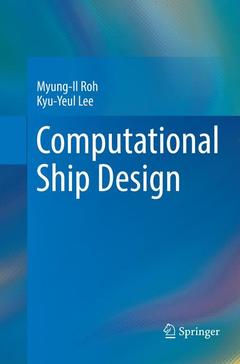Computational Ship Design, Softcover reprint of the original 1st ed. 2018
Auteurs : Roh Myung-Il, Lee Kyu-Yeul

This book offers an introduction to the fundamental principles and systematic methodologies employed in computational approaches to ship design. It takes a detailed approach to the description of the problem definition, related theories, mathematical formulation, algorithm selection, and other core design information.
Over eight chapters and appendices the book covers the complete process of ship design, from a detailed description of design theories through to cutting-edge applications. Following an introduction to relevant terminology, the first chapters consider ship design equations and models, freeboard calculations, resistance prediction and power estimation. Subsequent chapters cover topics including propeller deign, engine selection, hull form design, structural design and outfitting. The book concludes with two chapters considering operating design and economic factors including construction costs and fuel consumption.
The book reflects first-hand experiences in ship design and R&D activities, and incorporates improvements based on feedback received from many industry experts. Examples provided are based on genuine case studies in the field. The comprehensive description of each design stage presented in this book offers guidelines for academics, researchers, students, and industrial manufactures from diverse fields, including ocean engineering and mechanical engineering. From a commercial point of view the book will be of great value to those involved in designing a new vessel or improving an existing ship.
Preface.- 1 Introduction.- 2 Analysis of Ship Owner’s Requirements.- 3 Design Constraints.- 4 Estimation of Lightweight.- 5 Prediction of Resistance and Power.- 6 Selection of Main Engine.- 7 Determination of Principal Dimensions of Propeller.- 8 Estimation of Capacity of Cargo Hold.- 9 Calculation of Freeboard.- 10 Determination of Principal Dimensions.- 11 Hull Form Design.- 12 General Arrangement Design.- 13 Hull Structural Design.- 14 Outfitting Design.- 15 Economic Evaluation.- 16 Example of Determination of Principal Dimensions.- 17 Examples of Ship Design Model.- A.1. Introduction to optimum design.- A.2. Selective optimization methods.- A.3. Example of optimal dimension design.- A.4. Example of optimal arrangement design.- References.- Index.
Dr Myung-Il Roh is an Associate Professor in the Department of Naval Architecture and Ocean Engineering, Seoul National University, Korea. He is also a Head of Interdisciplinary Program in Offshore Plant Engineering at Seoul National University, Korea from 2016. He received the B.S. degree in 1998, the M.S. degree in 2000, and the Ph.D. degree in 2005 in naval architecture and ocean engineering from Seoul National University, Korea. Before joining the faculty of Seoul National University in 2013, he had worked as an assistant professor of the School of Naval Architecture and Ocean Engineering at University of Ulsan, Korea from 2007 to 2013. His teaching and research interests include design technologies of ships and offshore structures, such as optimization, simulation, computerization, and integration. He is a member of the Board of Directors of the Society for Computational Design and Engineering, an Editor for the PLOS ONE Journal and the International Journal of Computational Design and Engineering, and an Editorial Board member for the International Journal of Ocean Systems Engineering and the Journal of Shipping and Ocean Engineering. He published over 10 lecture notes, 120 journal papers, and 230 conference papers so far.
Dr Kyu-Yeul Lee is a Professor Emeritus in the Department of Naval Architecture and Ocean Engineering, Seoul National University, Korea. He received the B.S. degree in naval architecture and ocean engineering from Seoul National University, the M.S. degree, and the Ph.D. degree in naval architecture from the University of Hannover, Germany. His main areas of teaching and research interests include ship and offshore structure design, optimization, CAD, robotics, and multibody dynamics. He had worked as a research engineer and a lecturer at the University of Hannover and as a principal researcher and a project leader on ‘Computerized Ship Design and Production System’ at the Korea Research Institute of Ships and Ocean E
Date de parution : 01-2019
Ouvrage de 377 p.
15.5x23.5 cm
Date de parution : 10-2017
Ouvrage de 377 p.
15.5x23.5 cm
Thème de Computational Ship Design :
Mots-clés :
Hull form design; Hull form surface; Freeboard calculations; Structural ship design; Ship hull outfitting; Machinery outfitting; Propeller design; Electric outfitting; Optimal shipping route; Shipbuiding costs; Naval architectural design; Ship design equations; Computer-based ship design
